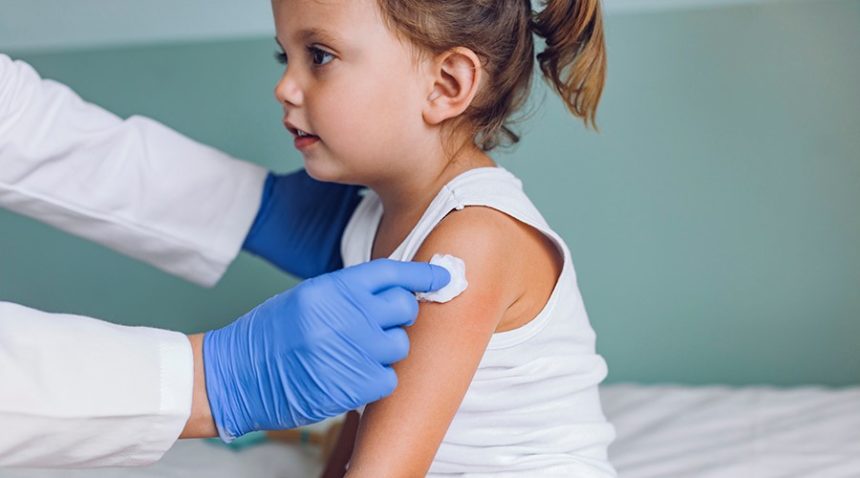Many parents of children younger than 12 have been waiting eagerly for their kids to be eligible for a COVID-19 vaccine. The wait might soon be over.
Pfizer recently released clinical trial data that shows its COVID-19 vaccine is safe and generates a “robust” antibody response in children ages 5 to 11. The company has submitted data to the Food and Drug Administration, which brings us one step closer to having the vaccine authorized for emergency use in children in this age range. In fact, healthcare experts predict children will be able to get their first shot in late fall.
We asked UNC Health pediatric infectious diseases specialist Peyton Thompson, MD, MSCR, what parents should know. Here are four things we learned.
1. The Pfizer vaccine is effective and safe in children.
The Pfizer clinical trial included 2,268 children ages 5 to 11. They were given two doses of the vaccine 21 days apart. The children were given a lower dose of the vaccine—10 micrograms, compared with 30 micrograms in people ages 12 and older.
The children’s immune responses were observed by measuring the antibody levels in their blood and comparing them with a control group of 16- to 25-year-olds who were given two shots of the larger 30-microgram dose.
“Initial data is quite promising and shows robust immune responses to the vaccine in children ages 5 to 11. It is both effective and safe in this age group,” Dr. Thompson says. “The timing of this is significant because we’ve seen COVID cases among children rise over 240 percent since July, and while hospitalization and death are less common among children infected with COVID than among adults, rates of both are increasing. Each hospitalization and each death are tragic, and soon to be preventable through vaccination.”
Trials for the Moderna COVID-19 vaccine also are underway for children ages 6 months to 11 years. Initial results should be reported later this fall.
“Pfizer is simply on a faster timeline than Moderna, but the vaccines themselves are relatively similar,” Dr. Thompson says.
2. Vaccine side effects in younger children are similar to those in teens.
The clinical trial data show that side effects of the Pfizer COVID-19 vaccine are similar across all age groups. They include a sore arm, headache, feeling tired, muscle aches and chills. These side effects are very similar to what researchers have seen in studies of teens and adults who get the Pfizer vaccine. Side effects were more often reported after the second dose than the first.
Rare side effects of both the Pfizer and Moderna vaccines include anaphylaxis (two to 11 cases per million doses given) and myocarditis (60 cases per million among teenage boys and eight cases per million teenage girls).
“There is a risk, albeit very small, for myocarditis after the Pfizer or Moderna vaccine. The cases that have been reported are generally mild, thankfully, with the majority experiencing full recovery and most not requiring hospitalization,” Dr. Thompson says. “Cases are more commonly seen among teenage boys than girls and are more common among teenagers than adults.”
It’s important to note that the risk of myocarditis from COVID-19 itself (450 cases per million) is much higher than the risk of myocarditis from the COVID-19 vaccines.
“The benefit of vaccination far outweighs the risk of myocarditis,” Dr. Thompson says.
3. Children younger than 5 are likely to be eligible in 2022.
Vaccinating children ages 5 to 11 will be beneficial for keeping schools open and helping to bring an end to the pandemic, but younger kids probably won’t be eligible until early next year.
Clinical trials are underway to evaluate the safety and effectiveness of the Pfizer and Moderna vaccines in children under 5. Researchers are testing smaller doses for this age group; Pfizer is testing 3 micrograms in the youngest children, just a tenth of the adult dose.
There are good reasons why the youngest children are the final group in a vaccine rollout. All clinical trials on humans prioritize safety, but growing children are a special population. Researchers want to make sure they have as much information as possible on safety, efficacy, dosage and immune response before giving the vaccines to children.
4. It’s important to continue vigilance to protect kids.
Because children younger than 12 are not yet able to receive a vaccine, it’s important for families to continue to follow COVID-19 safety precautions. The best way to do this is to get vaccinated yourself and to ask your child’s caregivers to get vaccinated as well. Unvaccinated caregivers should be masked around children at all times, and children should not be in crowds with people who might be unvaccinated.
Beyond vaccination, “everyone should wear masks indoors and in crowded outdoor areas, practice frequent hand-washing and maintain physical distancing, which will decrease their risk of exposure to COVID-19,” Dr. Thompson says. “And since we’re entering flu season, make sure everyone in your family gets a flu shot.”
Visit unchealthcare.org/vaccine for the latest information on the COVID-19 vaccines.

